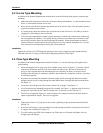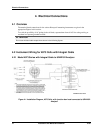
Introduction
10/07 Installation and Maintenance Manual 1
1. Introduction
1.1 Overview
The 4973 Type cells, Figure 1-1, have a rugged configuration for reliable, continuous measurements of
electrolytic conductivity in industrial water processes at temperatures up to 140°C at 250 psig. They are
applicable to such measurements as the effluent of distillation equipment; anion, cationic and mixed bed
ion exchangers; monitoring and controlling of washing electronic components; plating rinse tank control;
boiler water condensate; boiler hot well measurements and cooling tower blowdown, and many others.
Made of polyethersulfone (PES) construction for high-corrosion resistance, the cells are supplied with 0.01
and 0.1 cell constants having titanium electrodes, and 1.0 and 10.0 cell constants with high-density,
graphite electrodes.
The 4973 Cells used with UDA2182 Series or APT2000/4000 Series are equipped with the choice of:
• integral standard 20 or 50 foot lead
• quick disconnect cable option
• junction box type (universal) head with terminal connections for longer lead lengths.
For in-line applications, the 3/4” NPT male thread permits permanent installation in a pipe or tank; the cell
may also be used as a laboratory dip-type cell for batch sampling.
For flow applications, the cell can be installed directly into a process stream as shown in
Figure 1-2 by
using a Flow Chamber or a 3/4” pipe tee as shown in
Figure 1-3. These arrangements are designed to keep
both the temperature compensator and cell in the main stream flow so that the cell will respond more
quickly and accurately to process changes of both solution concentration and temperature.
A 316SS (P/N 31079198) and a PES (P/N 055919) Flow Chamber is available from Honeywell.
1.2 Description
All conductivity cells of the 4973 Type are suitable for use in both flow and insertion - type installations.
They are one-piece molded units that cannot come apart and therefore have no replacement parts. Each has
a 3/4” NPT thread.
The physical appearance of the cells is shown in
Figure 1-1. The 0.01, 0.1, 1 and 10 cell constants are
similar in construction with differences as noted below.
0.01 and 0.1 Cell Constants
The 0.01 cell differs from the others only by its outer electrode length of 2-3/4”. The temperature
compensation sensor is located inside the inner electrode. The holes in the outer electrode provide passage
for the solution being measured. The 0.1 cell is similar to the 0.01 type except that its outer electrode
length is 2”. The temperature compensation sensor is located inside the inner electrode.
1 and 10 Cell Constants
The 1 and 10 cell constant types are similar but differ in the width of flow channel (that serves to conduct
the solution being measured past the electrodes of the cell) as well as size and spacing of the electrodes.
The electrodes are graphite, 1/4” D for the 1 cell constant and 1/8” D for the 10 cell constant. The
temperature compensating sensor is integral with the cell body.


















